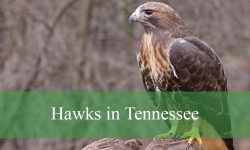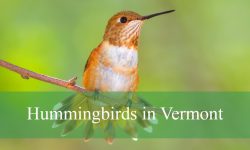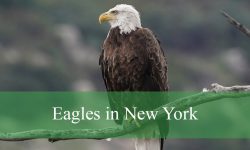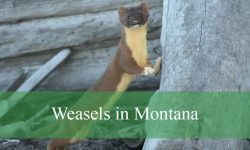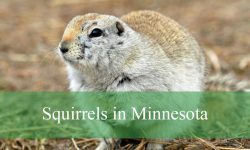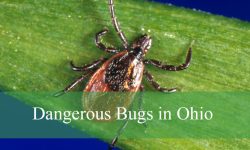Dragonflies are some of the most fascinating insects in Colorado, showcasing vibrant colors, unique wing patterns, and remarkable flight abilities. From small meadowhawks to large darners, the state hosts a wide variety of species across ponds, lakes, and wetlands.
These agile predators play an essential role in controlling insect populations, feeding on mosquitoes, flies, and other small insects. Observing them can be both a relaxing and educational experience, whether you are exploring mountain streams or urban ponds.
This guide highlights 28 types of dragonflies commonly found in Colorado, providing detailed identification tips, habitat preferences, and distinctive characteristics. Each species description is accompanied by helpful insights to make spotting and recognizing them easier.
Common Dragonflies Found in Colorado
Blue Dasher (Pachydiplax longipennis)
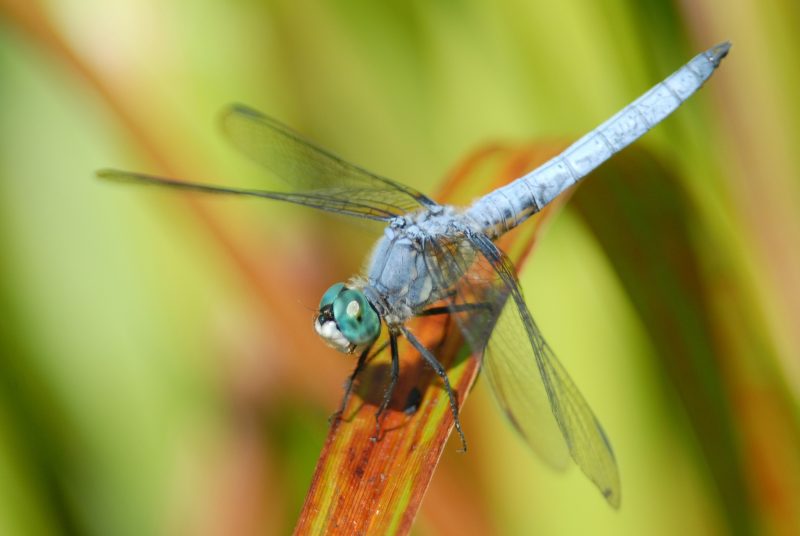
The Blue Dasher is a small yet striking dragonfly often spotted near ponds, marshes, and lakes across Colorado. Adult males are known for their powder-blue abdomens and dark-tipped tails, while females and juveniles display a more muted brown and yellow striped body. Their wings are clear with slight amber tinting near the base, giving them a delicate yet noticeable appearance when resting on vegetation. With a wingspan averaging about 2.5 to 3 inches, they are relatively small compared to other species in the region.
In terms of behavior, Blue Dashers are highly active during the summer months and are often observed perching on reeds or hovering low over the water in search of prey. They are agile hunters, feeding on small insects like mosquitoes, flies, and gnats, playing a vital role in controlling pest populations. Males are territorial, frequently returning to the same perch and chasing away rivals to protect their breeding grounds.
Within Colorado, Blue Dashers are widespread and can be found in both urban and rural water habitats. They adapt well to different aquatic environments, making them one of the most common species encountered by casual observers. Their preference for sunny, open areas makes them easy to spot, and their approachable nature means they are often photographed by dragonfly enthusiasts.
Common Green Darner (Anax junius)

The Common Green Darner is one of the largest and most recognizable dragonflies in Colorado, often reaching a wingspan of 3 to 4 inches. This species is named for its vivid green thorax, which contrasts with a long blue abdomen tipped with black. Both males and females share this striking coloration, making them stand out among other dragonflies. Their wings are clear and strong, built for long-distance flight, allowing them to cover vast areas during seasonal migrations.
Green Darners are known for their impressive migratory behavior, traveling hundreds of miles between breeding and overwintering grounds. In Colorado, they are most frequently seen during spring and fall migrations, stopping at lakes, reservoirs, and wetlands to rest and feed. They are fast and powerful fliers, capable of reaching speeds over 30 miles per hour, which helps them both catch prey and evade predators.
This species plays a crucial ecological role by consuming large quantities of mosquitoes, midges, and other small flying insects. Their distribution spans across the entire state, from plains to mountain foothills, wherever suitable water habitats exist. Because of their size, speed, and bright coloration, Green Darners are often the first dragonfly people notice when exploring nature in Colorado.
Twelve-Spotted Skimmer (Libellula pulchella)
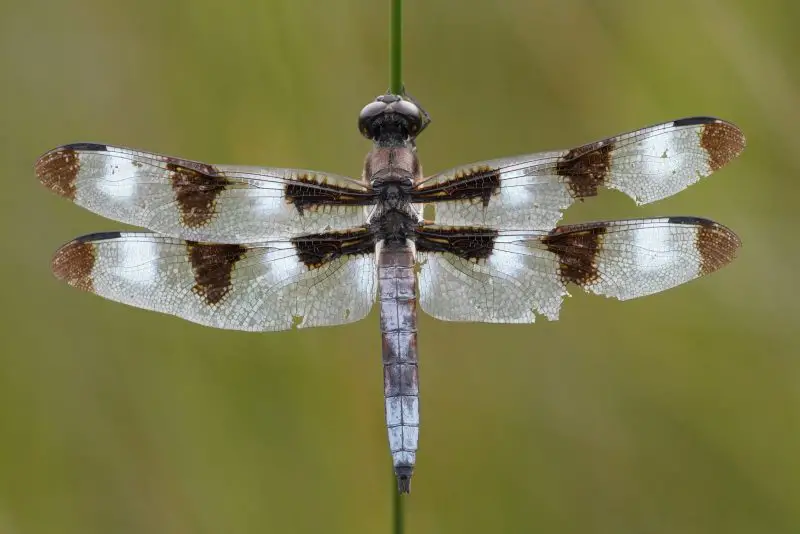
The Twelve-Spotted Skimmer is a medium-sized dragonfly with a wingspan of about 3 inches, easily recognized by the bold black and white patches on its wings. Males also display a powdery blue abdomen, while females retain a brownish tone with yellow stripes along the sides. These distinctive markings make the species one of the easiest dragonflies to identify in Colorado, even from a distance.
Behaviorally, Twelve-Spotted Skimmers are strong fliers that patrol open areas near ponds, slow-moving rivers, and wetlands. They often perch on tall stems or branches, where males keep watch over territories and chase away intruding rivals. Their hunting strategy involves short bursts of flight to capture insects midair, usually returning quickly to their perch after feeding.
In Colorado, this species is widespread during the summer months and thrives in sunny, open habitats with calm waters. Their striking wing pattern makes them a favorite among nature photographers and dragonfly watchers. Because they tolerate human presence fairly well, they are often seen near public parks, ponds, and garden water features.
Four-Spotted Skimmer (Libellula quadrimaculata)
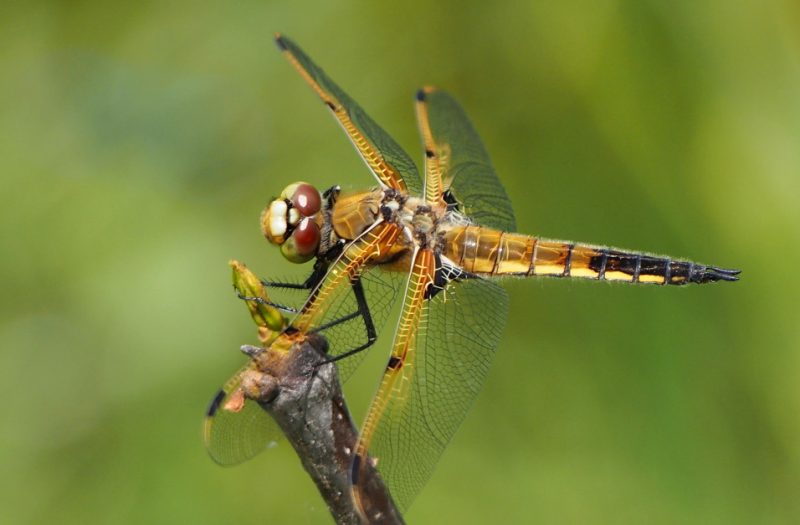
The Four-Spotted Skimmer is a medium-sized dragonfly named for the distinctive dark spots located at the midpoint of each wing. Its body is brown with subtle golden highlights, and its abdomen often appears slightly flattened. With a wingspan of about 2.5 to 3 inches, it is moderately sized, yet the spotted wing pattern makes it stand out easily in flight.
This dragonfly is an energetic flier, often observed hovering or darting rapidly over lakes, marshes, and bogs. Males are territorial, patrolling open stretches of water and chasing away competitors. They feed on flying insects, catching them with swift aerial maneuvers. Unlike some species that remain near perches, Four-Spotted Skimmers spend much of their time actively patrolling, which adds to their visibility.
In Colorado, they are found primarily in higher elevation wetlands, especially in the foothills and mountain lakes. They prefer cool, clean waters with abundant vegetation. Because of their distinctive wing markings and energetic flight style, they are a favorite species for identification among dragonfly enthusiasts exploring Colorado’s natural landscapes.
Widow Skimmer (Libellula luctuosa)
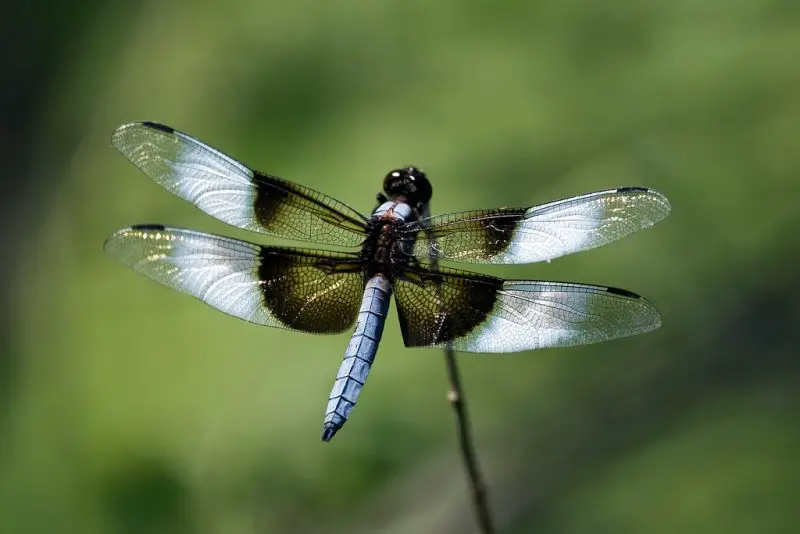
The Widow Skimmer is a large and showy dragonfly, reaching a wingspan of up to 3 inches. Its wings feature bold black bands near the base, which contrast with white patches on the males, while females retain only the darker markings. The abdomen of males is a pale powder-blue, whereas females show a brown abdomen with yellow striping. This dimorphism makes it easy to tell the sexes apart in the field.
Widow Skimmers are perch-hunters, often seen resting on tall grasses or branches near water. From these perches, they launch into quick flights to capture prey before returning to the same spot. Males establish and defend territories near ponds and slow streams, while females visit only when ready to lay eggs. Their hunting efficiency makes them an important predator of small flying insects.
In Colorado, Widow Skimmers are common in lowland ponds, lakes, and marshes throughout the summer months. They prefer sunny, open habitats with still or slow-moving water. Because of their large size, bold wing markings, and frequent perching behavior, they are one of the most easily recognized dragonflies in the state, often spotted by casual observers and wildlife photographers alike.
Black Saddlebags (Tramea lacerata)

The Black Saddlebags is a medium-to-large dragonfly known for the dark, saddle-shaped patches on its hindwings. Its body is mostly black, with slender features that make it appear elegant in flight. With a wingspan reaching 2.5 to 3 inches, this species is highly noticeable when gliding over open water. These unique wing markings are the best way to identify them, especially since they are often seen flying high above ponds and lakes.
Behaviorally, Black Saddlebags are strong fliers and rarely perch for long, spending much of their time soaring in open skies. They migrate seasonally, traveling long distances across North America, and are often seen in groups while moving south during late summer. As aerial predators, they consume swarms of mosquitoes, gnats, and other small insects, capturing them while in constant flight.
In Colorado, Black Saddlebags are common around large water bodies, especially during migration periods. They prefer open, sunny habitats and are often observed patrolling well above eye level. Because of their distinctive saddle-like markings and tendency to soar, they are a familiar sight to birdwatchers and hikers scanning the skies near lakes and wetlands.
Red Saddlebags (Tramea onusta)
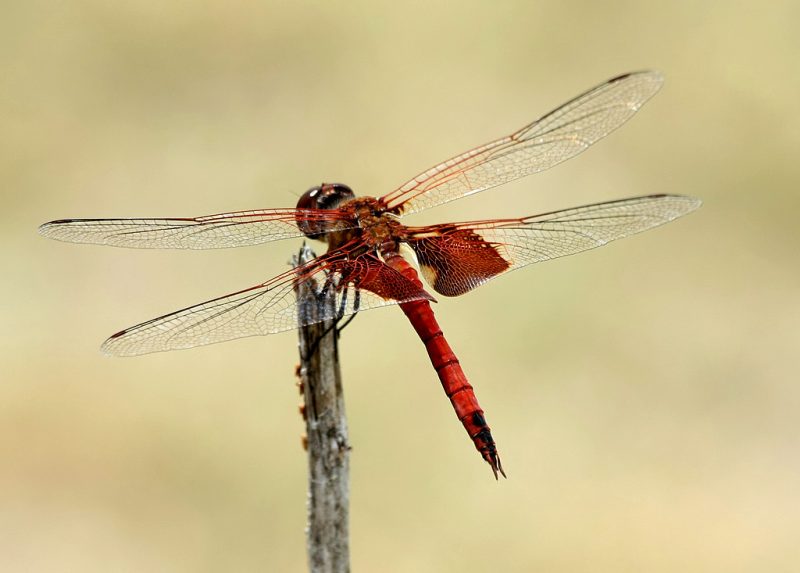
The Red Saddlebags is a striking dragonfly with a reddish-brown body and bold dark patches on its hindwings that resemble a pair of saddlebags. Slightly smaller than its black cousin, it has a wingspan of around 2.5 inches. The rich red coloration of the abdomen makes males especially easy to identify, while females display more muted brown tones with similar wing markings.
This species is a skilled flyer, spending much of its time gliding and patrolling open water. Like the Black Saddlebags, it is migratory and often observed in groups moving across long distances. Their feeding habits consist of catching small flying insects midair, and they rarely land for extended periods, which makes close observation somewhat challenging.
Within Colorado, Red Saddlebags are typically seen around ponds, lakes, and reservoirs during the summer months. They prefer wide, open water sources with abundant sunlight and can be found both in lowland areas and foothill regions. Their vivid red coloring, paired with the characteristic wing patches, makes them a favorite for dragonfly enthusiasts hoping to spot something colorful in flight.
Western Pondhawk (Erythemis collocata)
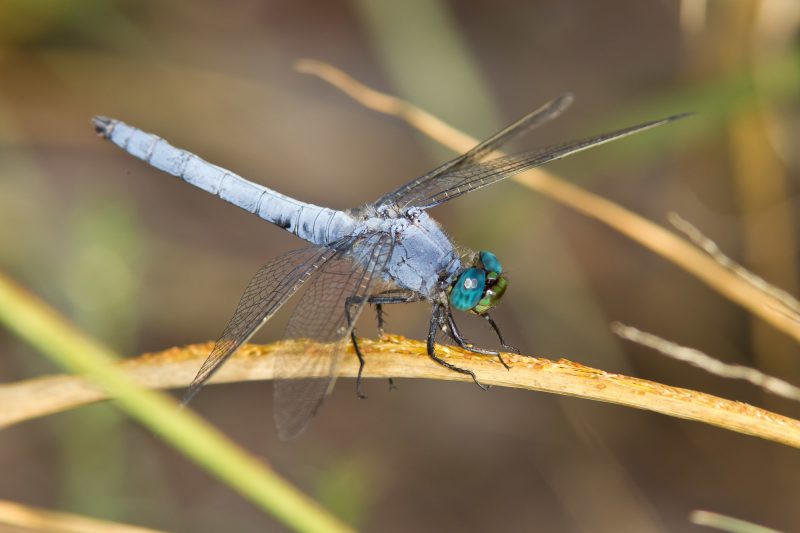
The Western Pondhawk is a medium-sized dragonfly with males showcasing a distinctive powder-blue body, while females are green with black striping on the abdomen. This sexual dimorphism makes it easy to differentiate between the sexes. Their wings are clear and strong, and they typically span about 2.5 inches, allowing them to maneuver swiftly while hunting.
Pondhawks are aggressive hunters, often seen capturing prey nearly as large as themselves. They perch low on vegetation or even directly on the ground before darting out to snatch passing insects. Males are territorial, frequently guarding their chosen hunting and breeding spots, while females prefer more concealed areas until ready to mate.
In Colorado, the Western Pondhawk is found around ponds, lakes, and slow-moving streams, especially in warm, sunny habitats. They are widespread in both urban parks and rural wetlands. Their adaptability and bold behavior make them a common sight in summer, and their habit of perching at ground level makes them more approachable for close observation compared to other dragonflies.
White-Tailed Skimmer (Plathemis lydia)
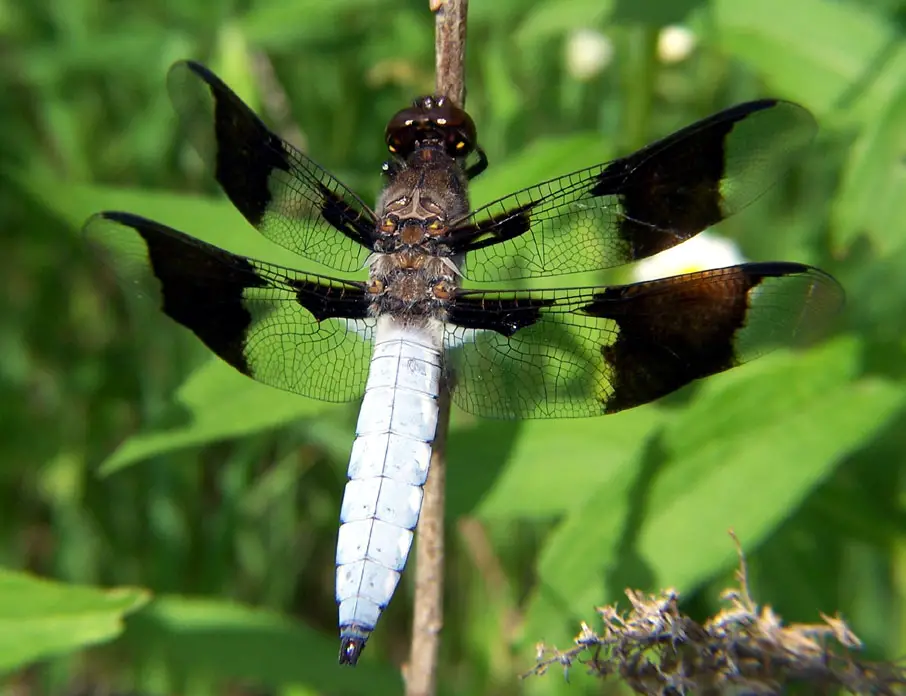
The White-Tailed Skimmer is a large and robust dragonfly with a wingspan of 2.5 to 3 inches. Males are instantly recognizable by their bright white abdomen, which contrasts with black thoracic markings and bold black patches at the bases of their wings. Females, on the other hand, have brown bodies with yellow striping, along with the same dark wing patches, making the sexes relatively easy to distinguish.
This species is highly territorial, with males often seen hovering and patrolling around ponds and lakes. They are perch-oriented hunters, frequently returning to the same spot after short flights to capture prey. Their striking appearance, coupled with their active territorial behavior, makes them one of the more charismatic dragonflies in Colorado’s wetlands.
In Colorado, White-Tailed Skimmers are widespread in summer, especially around still or slow-moving waters with plenty of emergent vegetation. They prefer sunny, open areas where perches are abundant. Because of their bold black-and-white contrast, they are one of the most easily recognized dragonflies, often among the first identified by beginners.
Flame Skimmer (Libellula saturata)

The Flame Skimmer is one of the most brilliantly colored dragonflies found in Colorado, with males displaying fiery red-orange bodies and wings that glow with amber highlights. Females are typically more subdued in color, showing brownish bodies with amber-tinted wings, but they still retain a warm appearance. With a wingspan of about 3 inches, this species is large and highly visible.
True to its name, the Flame Skimmer is a bold and energetic flier, frequently seen patrolling near ponds, streams, and hot springs. Males establish territories and perch prominently, making them easier to observe than more elusive species. They hunt a variety of insects, catching them midair with remarkable precision, and return to their perches afterward.
In Colorado, Flame Skimmers are most common in the warmer regions of the state, particularly in the southern and western areas. They are often found in sunny aquatic habitats where emergent vegetation is abundant. Their brilliant coloration makes them one of the most eye-catching dragonflies in the region, often leaving a lasting impression on anyone who spots them.
Variable Darner (Aeshna interrupta)
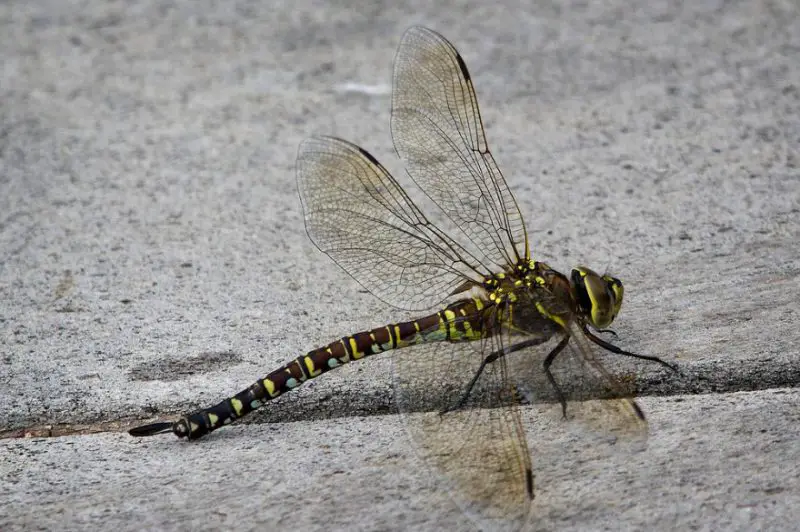
The Variable Darner is a large dragonfly with a wingspan ranging from 3 to 3.5 inches, making it one of the more prominent species found in Colorado. Its thorax features bold diagonal stripes, while the abdomen is marked with blue or green spots depending on the individual. This variability in coloration is what gives the species its common name, as patterns can differ between populations and even among individuals.
Variable Darners are strong, agile fliers often patrolling over ponds, bogs, and marshy wetlands. Males are territorial, actively defending stretches of shoreline by flying back and forth in search of rivals or potential mates. They are excellent hunters, feeding on a wide range of insects including mosquitoes, flies, and other small flying invertebrates.
In Colorado, they are most commonly found in cooler habitats at higher elevations, particularly in mountain lakes and bogs. Their adaptability to northern and alpine environments makes them more widespread in the mountainous regions of the state than on the plains. For dragonfly watchers, their large size and distinctive flight pattern make them relatively easy to spot.
Shadow Darner (Aeshna umbrosa)
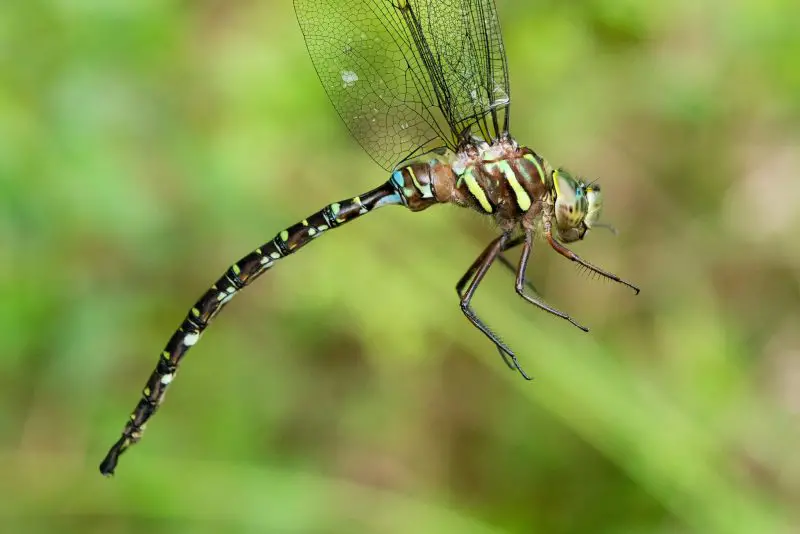
The Shadow Darner is a dark-colored species that blends well into shaded woodland habitats. It has a brown thorax with greenish stripes and a long, dark abdomen marked with blue spots. With a wingspan of 3 to 3.5 inches, it is a fairly large dragonfly, but its subdued coloration allows it to remain less conspicuous compared to brighter species.
Unlike many dragonflies that favor open, sunny spaces, the Shadow Darner is often active in shaded areas near forest ponds, streams, and marshes. It is most active during late afternoon and even at dusk, giving it its common name. Males patrol low and steady flight paths through shaded areas, while females are usually seen when laying eggs in submerged vegetation.
In Colorado, Shadow Darners are most frequently found in forested regions of the foothills and mountains, where shaded wetlands provide their ideal environment. Their preference for darker habitats makes them a unique find for observers, as they are often among the last dragonflies flying as evening sets in.
Paddle-Tailed Darner (Aeshna palmata)
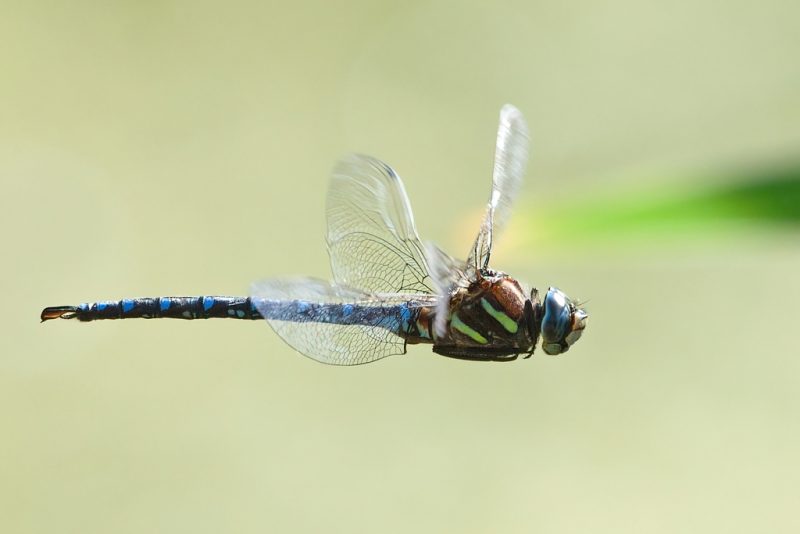
The Paddle-Tailed Darner is recognized by its distinctive paddle-shaped spots on the sides of its abdomen, which set it apart from other darners. Its thorax is brown with green or blue stripes, and its abdomen carries blue markings. Measuring 3 to 3.5 inches in wingspan, it is similar in size to other darners but more easily identifiable due to the unique “paddle” marks.
Behaviorally, Paddle-Tailed Darners are powerful fliers that patrol lakeshores, bogs, and marshes. Males are often observed flying in looping patterns over water as they guard territories. They are voracious insect hunters, catching prey midair and rarely staying still for long. When they do perch, they often hang vertically on vegetation.
In Colorado, this species is usually found in high-elevation wetlands and boggy areas, especially in the mountainous regions. They prefer cooler, shaded aquatic habitats. Their unusual markings make them a rewarding discovery for naturalists seeking out dragonflies in alpine or subalpine wetlands.
Striped Meadowhawk (Sympetrum pallipes)
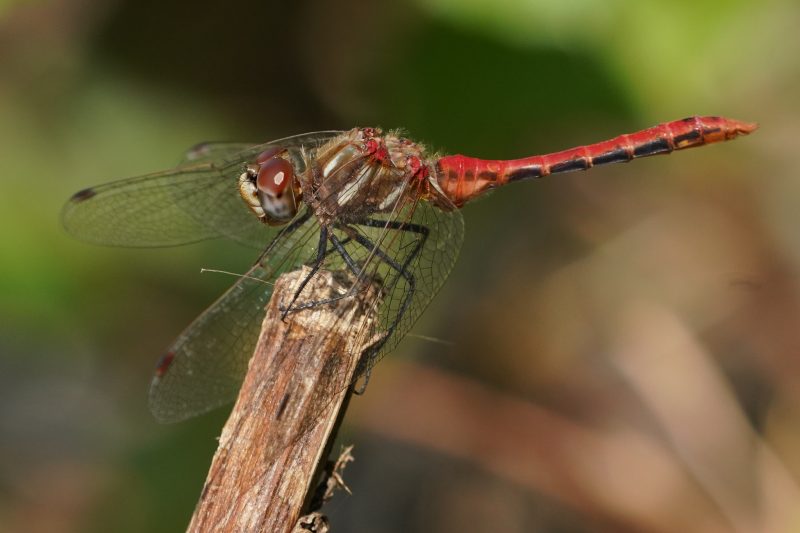
The Striped Meadowhawk is a smaller dragonfly, averaging 1.5 to 2 inches in wingspan. It has a slender body with light brown to reddish coloration, often showing pale stripes on the thorax. Unlike many meadowhawks, its markings are more subtle, giving it a softer appearance. Both males and females are similar in size, but males often develop more reddish tones as they mature.
This species is a perch-hunting dragonfly that spends much of its time resting on low vegetation or the ground, darting up quickly to catch flying insects. Males are territorial, defending sunny patches near ponds and streams. Their flight is short and erratic compared to the long glides of larger species, making them quick and agile hunters.
In Colorado, Striped Meadowhawks are found in a variety of habitats, from grasslands and meadows to ponds and reservoirs. They thrive in drier habitats compared to many other dragonflies and can even be spotted away from water sources. Their adaptability makes them a widespread meadowhawk across the state.
Cherry-Faced Meadowhawk (Sympetrum internum)
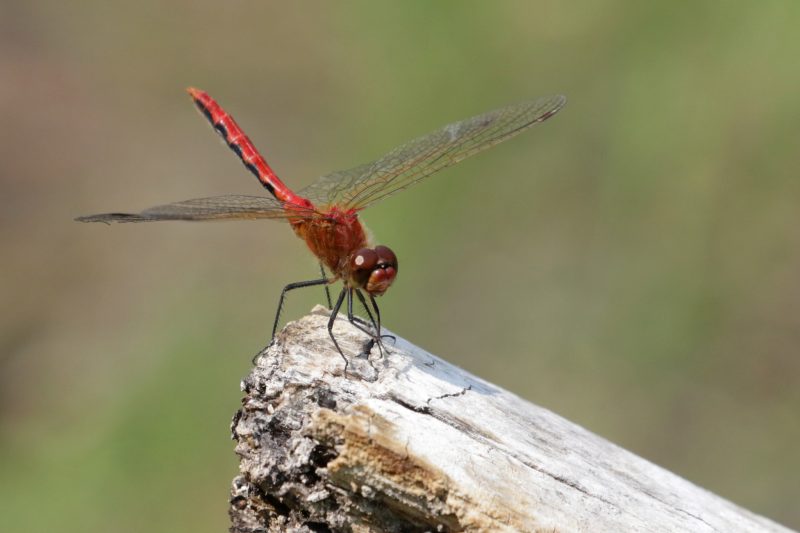
The Cherry-Faced Meadowhawk is a small but vivid dragonfly, usually around 1.5 to 2 inches in wingspan. Mature males are distinguished by their brilliant red abdomens and red faces, while females and immature individuals are brownish with yellow striping. Their wings are clear, sometimes with slight amber shading near the base, giving them a delicate appearance in sunlight.
Cherry-Faced Meadowhawks are perch-oriented, often found resting on grasses, shrubs, or the ground near water. Males defend territories in sunny, open spots and make short, fast flights to intercept rivals or catch prey. They feed primarily on mosquitoes, flies, and other small flying insects, helping keep populations under control.
In Colorado, this species is commonly found in lakes, ponds, and wetlands during summer and early fall. They are widespread across both plains and mountain foothills, particularly in areas with still or slow-moving water. Their bright coloration makes them one of the most attractive and easily noticed meadowhawks in the state.
Autumn Meadowhawk (Sympetrum vicinum)
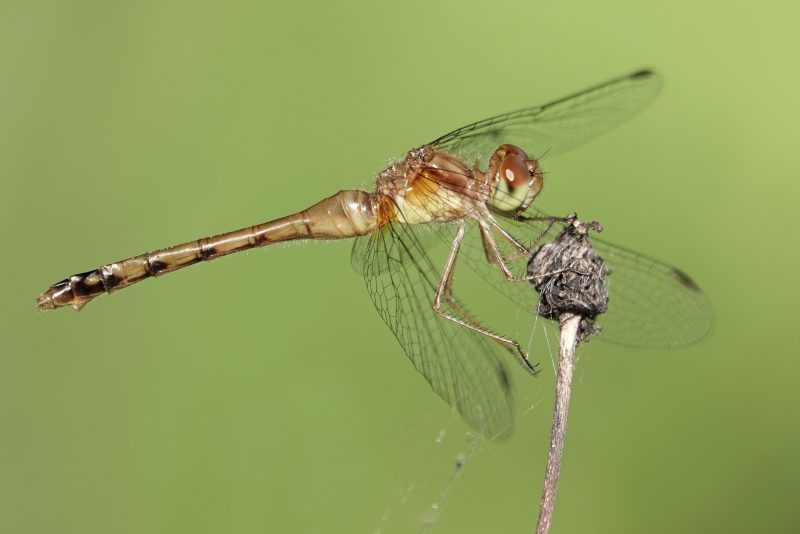
The Autumn Meadowhawk is a small dragonfly with a wingspan of about 1.5 to 2 inches, known for flying late into the season when most other dragonflies have disappeared. Mature males are bright red, while females are yellowish to brown with subtle markings. Both sexes have clear wings with a slight amber tint near the base, making them appear delicate against the autumn sunlight.
Unlike many dragonflies, Autumn Meadowhawks are tolerant of cooler weather and can often be found flying well into October and November. They are perch-hunters, frequently resting on rocks, grasses, or even human clothing as they bask in the sun. Their flight is relatively short and direct, often returning to the same perch after catching prey.
In Colorado, this species is widespread across ponds, lakes, and wetlands, particularly in lower elevations. Their late-season activity makes them one of the last dragonflies people see each year. Because of their friendly behavior and willingness to perch near humans, they are a favorite among nature watchers.
Band-Winged Meadowhawk (Sympetrum semicinctum)
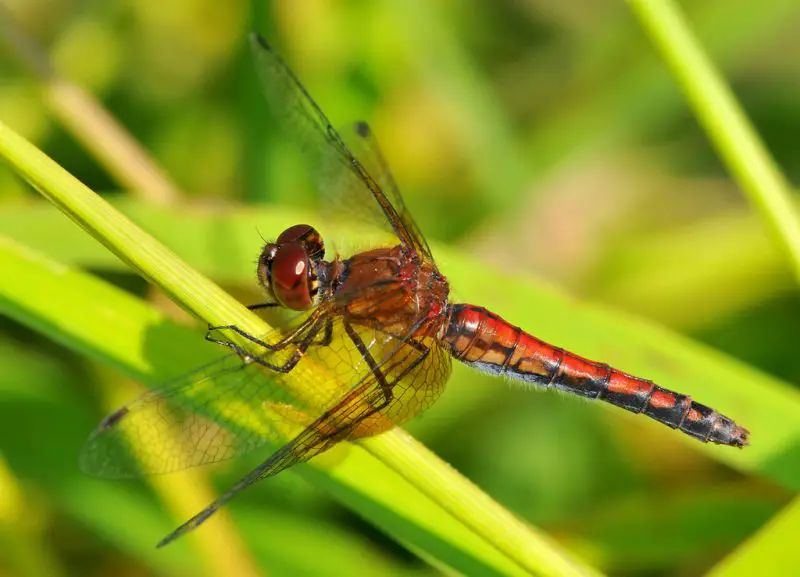
The Band-Winged Meadowhawk is easily recognized by the distinct dark bands that stretch across the bases of its wings. Males display bright red abdomens, while females are generally brown or yellow with darker markings. With a wingspan of 1.5 to 2 inches, they are relatively small, but the bold wing bands make them stand out in flight.
This species is active and agile, often flying low over open fields and meadows near water sources. Males are territorial and can be seen perching on grasses or twigs, darting out to intercept rivals or catch prey. Their flight style is quick and somewhat erratic, giving them an energetic presence in their habitats.
In Colorado, Band-Winged Meadowhawks are widely distributed across both plains and mountain foothills. They prefer sunny habitats with still or slow-moving water. Their striking wing bands make them one of the most distinctive meadowhawks, often noticed even by casual observers.
Cardinal Meadowhawk (Sympetrum illotum)
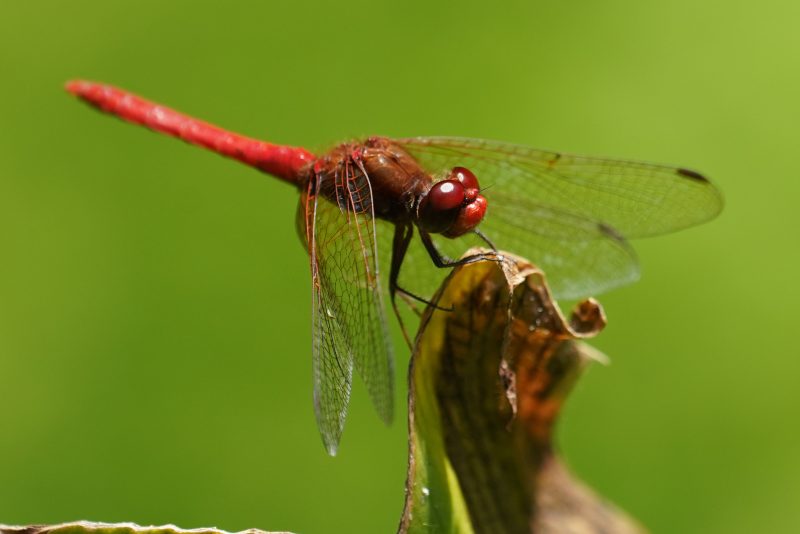
The Cardinal Meadowhawk is one of the most brilliantly colored meadowhawks, with mature males showcasing a deep scarlet red body and clear wings. Females and immature individuals are yellowish-brown with darker markings, gradually turning more vivid as they mature. With a wingspan of around 1.5 to 2 inches, they are small but extremely eye-catching.
Cardinal Meadowhawks are strong perch-hunters, often seen basking in sunny spots near ponds, lakes, and streams. Males are highly territorial, guarding their perching sites with aggressive flights. They feed on mosquitoes, gnats, and other small flying insects, making them important predators in their ecosystems.
In Colorado, they are most commonly found in warmer regions, particularly in the southern parts of the state. Their preference for sunny, open wetlands makes them most visible during midsummer. Because of their bold red coloration, they are among the most photogenic meadowhawks found in Colorado.
Variegated Meadowhawk (Sympetrum corruptum)
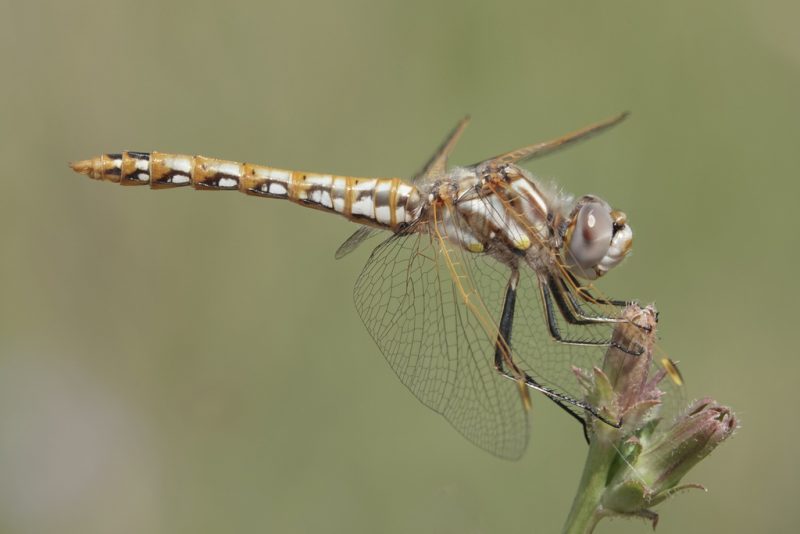
The Variegated Meadowhawk is a medium-sized dragonfly with a wingspan of 2 to 2.5 inches, known for its complex and mottled color patterns. Males are reddish with brown and black markings, while females are more muted in tone, showing yellow and brown streaks. Their wings often display amber and dark patches near the base, adding to their distinctive look.
This species is a long-distance migrant, capable of traveling hundreds of miles during seasonal movements. They are often seen in large numbers during migration, flying across open landscapes far from water. Their flight is strong and purposeful, with males occasionally defending territories when they settle near wetlands.
In Colorado, Variegated Meadowhawks are common in both lowlands and mountain valleys during migration periods. They can be spotted in a wide range of habitats, from ponds and reservoirs to open fields and grasslands. Their migratory behavior and variable coloration make them one of the most fascinating meadowhawks in the state.
Blue-Eyed Darner (Rhionaeschna multicolor)

The Blue-Eyed Darner is a large and striking dragonfly, reaching a wingspan of 3 to 3.5 inches. True to its name, it has vivid blue eyes that stand out against its brown thorax, which is marked with green and blue stripes. The abdomen is patterned with blue spots, giving it a bright and colorful appearance compared to other darners.
This species is a powerful flier, often seen patrolling over ponds, lakes, and streams. Males establish territories and fly back and forth along shorelines, while females are usually spotted when ovipositing in vegetation. Their strong flight and bright colors make them easy to identify, especially in sunny conditions.
In Colorado, Blue-Eyed Darners are widespread across both plains and mountain regions. They are often among the most common large dragonflies seen in summer, particularly in lowland wetlands and reservoirs. Their brilliant blue eyes and vivid body markings make them one of the most striking dragonflies to encounter in the state.
Canada Darner (Aeshna canadensis)

The Canada Darner is a large dragonfly commonly found across northern North America, including the cooler regions of Colorado. It is recognized by its striking blue markings on a dark brown body, along with a distinctive “notch” on the thoracic stripes. Its wings are clear, and males often display bright blue abdominal spots that make them easier to identify in flight.
This species prefers lakes, ponds, and slow-moving streams surrounded by forests or wetlands. Adults are strong fliers, often patrolling above the water or darting through woodland openings in search of prey. They are most active in summer, though they can remain present well into the fall.
Canada Darners feed primarily on mosquitoes, flies, and other small flying insects, making them beneficial for natural insect control. Their fast flight and agile maneuvering allow them to catch prey midair with ease.
In Colorado, they are typically spotted in higher elevations or cooler habitats. Their range overlaps with several other darners, but careful observation of their thoracic patterns helps distinguish them.
Mottled Darner (Aeshna clepsydra)
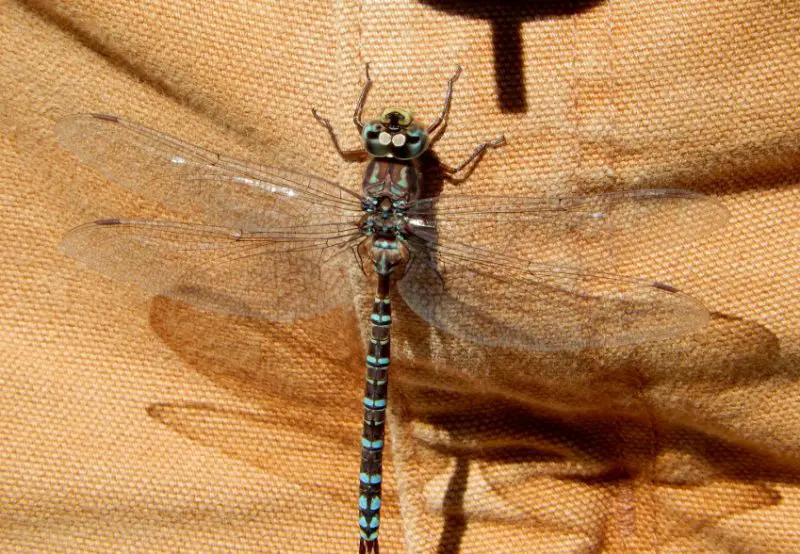
The Mottled Darner is a less common species in Colorado, usually found in the northern and central parts of the state. It has a distinctive pattern of irregular pale spots along the abdomen and mottled thoracic stripes, which give the species its name. Males tend to show blue markings, while females often display green.
This darner inhabits marshes, boggy ponds, and slow-moving waters with plenty of emergent vegetation. It is often seen flying low along shorelines or darting across open water. Their activity peaks in late summer, particularly from July through September.
Like other darners, they are voracious predators, capturing midges, mosquitoes, and other small insects in flight. They are capable of flying long distances, which helps them patrol wide hunting areas.
The Mottled Darner can be challenging to identify due to its similarity to other darners, but the irregular thoracic stripes and abdominal spotting provide reliable distinguishing features.
Plains Emerald (Somatochlora ensigera)
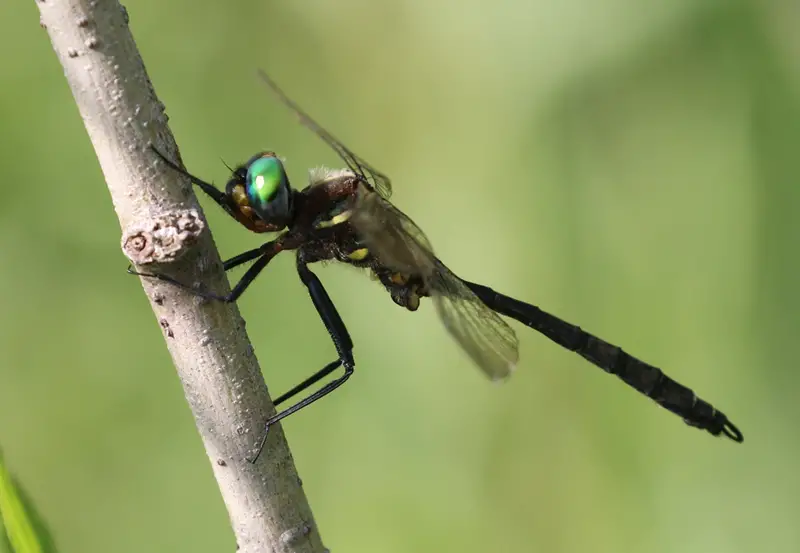
The Plains Emerald is a sleek, metallic-green dragonfly with bright green eyes and a slender, dark abdomen. Its shimmering body gives it a jewel-like appearance, especially when seen in direct sunlight. Unlike many brightly patterned dragonflies, its subtle metallic sheen makes it stand out.
It is often found in prairie wetlands, ponds, and small lakes across Colorado’s plains and foothills. This species prefers habitats with open skies, where it patrols tirelessly in search of food. Plains Emeralds are fast and powerful fliers, often flying in loops and sudden bursts of speed.
Their diet consists mainly of mosquitoes, gnats, and small flies, which they capture on the wing. They are particularly active during warm summer days but may also be observed in the evenings when insect activity is high.
Although not as abundant as skimmers or meadowhawks, the Plains Emerald is a rewarding find for dragonfly enthusiasts in Colorado due to its distinctive metallic body and energetic flight behavior.
Lake Darner (Aeshna eremita)
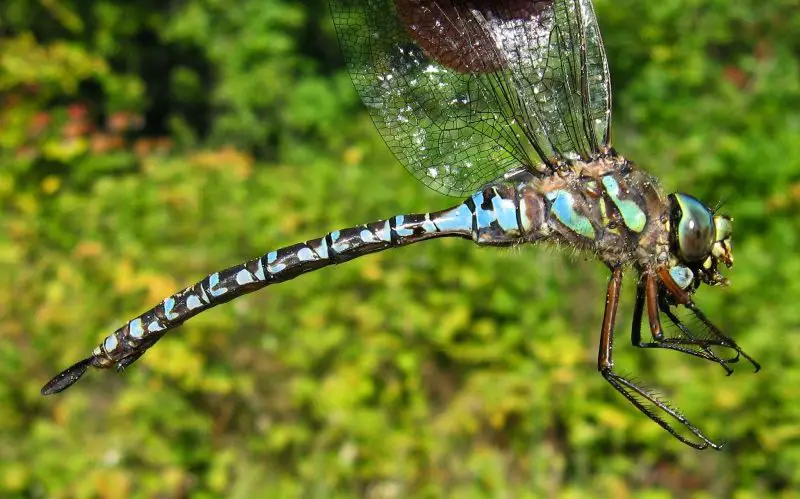
The Lake Darner is one of the largest dragonflies found in Colorado, with a long body and broad wings. It is dark brown with bright blue or green abdominal spots and a pair of bold thoracic stripes. Its sheer size makes it an impressive species to encounter.
As its name suggests, this species favors large lakes, deep ponds, and other expansive water bodies. It often patrols shorelines, sometimes flying low over the water or cruising along treelines. Lake Darners are particularly active during late summer and early autumn.
Their feeding habits are similar to other darners, targeting mosquitoes, small flies, and even other insects nearly their own size. They are agile hunters, able to chase prey across open water or through dense vegetation.
In Colorado, they are more frequently found in mountain lakes and cooler habitats. Their presence is a good indicator of healthy aquatic ecosystems.
California Darner (Rhionaeschna californica)
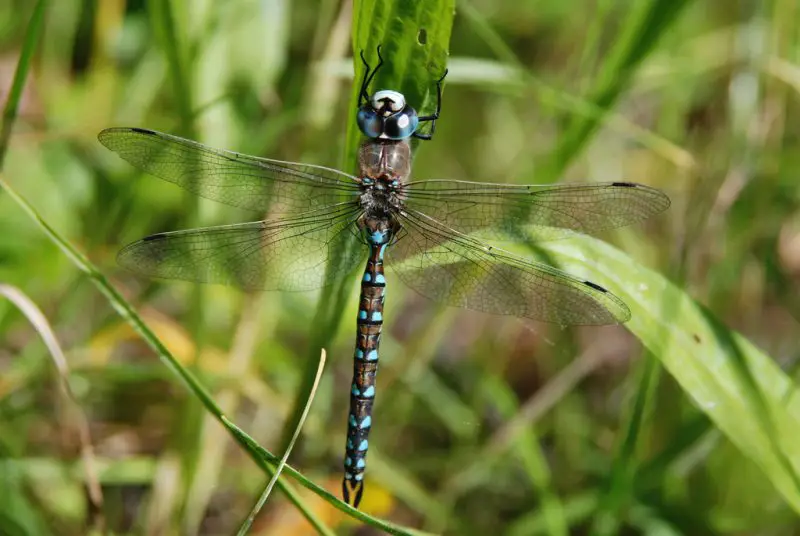
The California Darner is a striking species with a brown body marked by bright blue spots on the abdomen and green to blue thoracic stripes. Its coloration is vibrant, making it one of the more visually appealing dragonflies in Colorado.
This species inhabits ponds, lakes, and slow-moving streams, often preferring areas with surrounding vegetation. It is most active in spring and early summer, flying earlier in the season than many other darners.
California Darners are excellent aerial hunters, capturing mosquitoes, gnats, and other flying insects in midair. They are often seen hovering briefly before darting forward to seize their prey. Their long, powerful wings allow them to sustain fast flight over extended periods.
In Colorado, they are generally found in lower elevations and warmer areas compared to northern darners. Their early flight season makes them an important part of the spring dragonfly community.
Common Whitetail (Plathemis lydia)
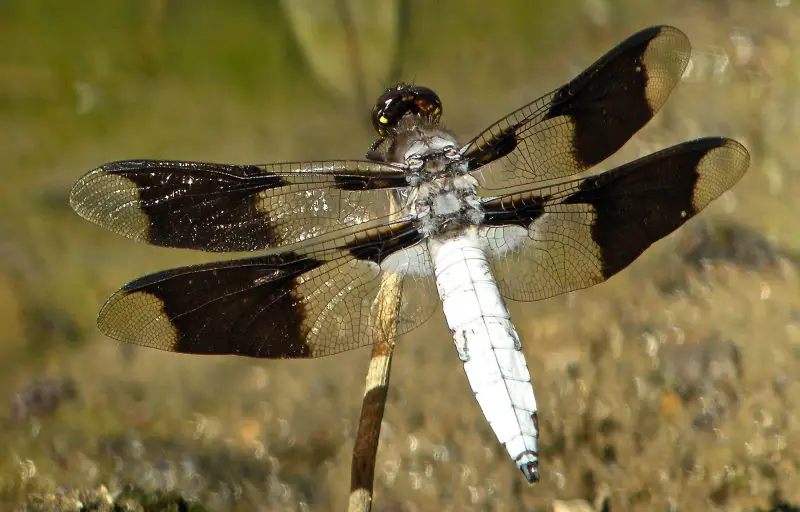
The Common Whitetail is a robust dragonfly with a wingspan of about 2.5 to 3 inches, easily recognized by the wide, white abdomen of the males, which contrasts sharply with the dark thorax and black patches at the wing bases. Females are brown with yellowish stripes and have similar wing markings. Its stocky body and bold coloration make it one of the most conspicuous dragonflies in Colorado.
Behaviorally, Common Whitetails are perch-oriented hunters, frequently resting on rocks, logs, or emergent vegetation near ponds and lakes. Males are territorial and will chase away intruders, while females usually remain near the water only for egg-laying. They feed aggressively on mosquitoes, flies, and other small insects, often returning to the same perch after capturing prey.
In Colorado, they are widespread across lowland ponds, reservoirs, and slow-moving streams during the summer months. They favor sunny, open habitats with ample perches, making them highly visible to dragonfly enthusiasts. Their bold appearance and active hunting behavior make them a favorite species to observe.
Eight-Spotted Skimmer (Libellula forensis)
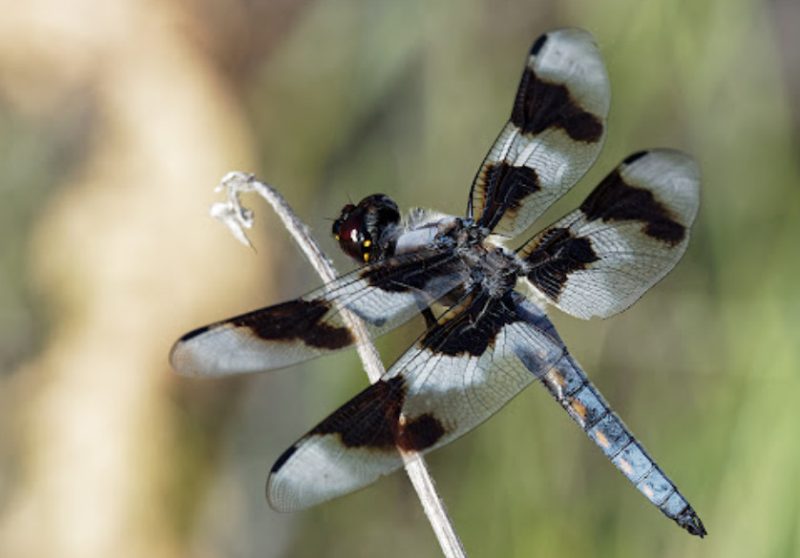
The Eight-Spotted Skimmer is a medium-sized dragonfly with a wingspan of around 3 inches, identified by the eight distinct dark spots on its wings—four on each side. Males also develop blue coloration on the abdomen, while females are brown with yellow stripes. The clear wings with contrasting dark spots make this species easy to identify, even from a distance.
This dragonfly is an energetic flier, often seen patrolling the edges of ponds, marshes, and slow streams. Males are highly territorial, defending sunny perches and chasing away rivals. They feed on a variety of small flying insects, capturing them midair with agile maneuvers.
In Colorado, Eight-Spotted Skimmers are found throughout the summer in both urban and rural water habitats. They prefer sunny, open areas with calm water and abundant vegetation. Their striking wing pattern and active behavior make them a favorite among dragonfly watchers.
Roseate Skimmer (Orthemis ferruginea)
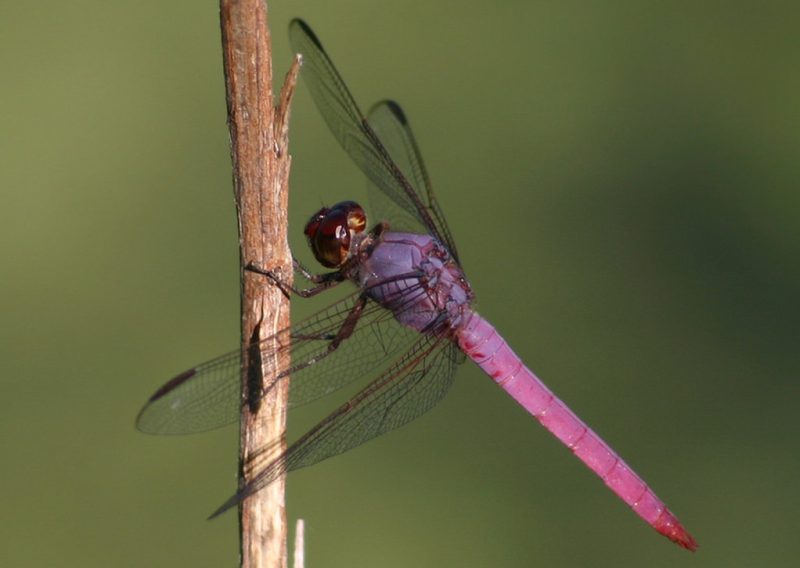
The Roseate Skimmer is a medium-sized dragonfly known for its vibrant pink to reddish coloration in males, while females are more orange or yellowish with subdued markings. Their wings are clear with a faint tint, and the wingspan ranges from 2.5 to 3 inches. This species’ bright, rose-colored body makes it one of the most visually striking dragonflies in Colorado.
Roseate Skimmers are perch-hunters, often resting on vegetation near ponds, ditches, or slow streams. Males establish territories and make short flights to intercept rivals or capture prey. They feed on small insects such as mosquitoes and flies, making them an active and important predator in their habitats.
In Colorado, Roseate Skimmers are most common in the warmer regions and are typically seen in lowland ponds and reservoirs during the summer months. Their brilliant coloration and bold presence make them one of the easiest dragonflies to spot for casual observers and photographers alike.
FAQs About Dragonflies in Colorado
What are the most common dragonflies in Colorado?
Colorado hosts a diverse array of dragonflies, with species like the Blue Dasher, Common Green Darner, Twelve-Spotted Skimmer, and Widow Skimmer being among the most frequently observed. Other popular species include the Flame Skimmer, White-Tailed Skimmer, and several meadowhawks such as the Cherry-Faced Meadowhawk and Autumn Meadowhawk.
Where can I find dragonflies in Colorado?
Dragonflies are commonly found near ponds, lakes, reservoirs, marshes, and slow-moving streams. Many species, including the Black Saddlebags and Red Saddlebags, prefer open water areas with abundant sunlight, while species like the Shadow Darner and Canada Darner favor shaded forested wetlands. Higher elevation lakes and mountain wetlands are ideal for certain darners like the Paddle-Tailed Darner and Lake Darner.
When is the best time to see dragonflies in Colorado?
The majority of dragonflies are active during the summer months, from late May to early September. Some species, like the Autumn Meadowhawk and Variegated Meadowhawk, are also active in late summer and fall. Darners and skimmers are typically most visible during warm, sunny days when they hunt and patrol open water habitats.
How can I identify different dragonfly species?
Identification is based on size, body coloration, wing patterns, and behavior. For example, the Twelve-Spotted Skimmer has distinctive black and white patches on its wings, while the Blue Dasher has a powder-blue abdomen. Meadowhawks are smaller and often red or yellow, while darners are larger with patterned thoraxes and long abdomens. Observing perching behavior, flight style, and preferred habitat can also help distinguish species.
Do dragonflies migrate in Colorado?
Yes, several species, including the Common Green Darner, Variegated Meadowhawk, and Black Saddlebags, undertake seasonal migrations. These dragonflies can travel long distances across the state and beyond, often congregating around large water bodies to rest and feed during their journey.
What do dragonflies eat?
Dragonflies are predators that feed almost exclusively on small flying insects such as mosquitoes, flies, midges, and gnats. Larger species, like darners, may also catch smaller dragonflies or butterflies. Their hunting occurs midair, and they often return to perches after capturing prey.
Are dragonflies beneficial to humans?
Absolutely. Dragonflies play a key role in controlling insect populations, particularly mosquitoes. By preying on swarms of insects, they help reduce pests in gardens, parks, and near water bodies, making them valuable allies for natural pest control.
Can dragonflies sting or bite humans?
No, dragonflies do not sting and their bites are harmless. While they have strong mandibles for catching prey, they rarely bite humans. They are generally non-aggressive and are safe to observe closely.
How long do dragonflies live in Colorado?
Most adult dragonflies live for a few weeks to a few months. However, their life cycle includes a nymph stage that can last from several months to a few years underwater before emerging as adults. This aquatic stage is crucial for their development and survival.

